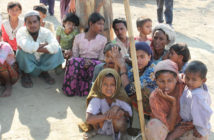A new report from a charity in New Zealand has revealed a surge in violence against women in the country’s South Asian community. Auckland’s Roopa Aur Aap trust says the number of victims in its care has doubled to 1,000 in just two years. Yet it adds that the issue of domestic violence remains “drastically under-reported”, largely because many women believe it is a private affair and they simply can’t explain to outsiders “why they are expected to treat their husbands like gods”.
The report illustrates the ongoing challenge of gender-based violence among Asian communities, many of which remain locked in a spiral of shame and trauma. Across the continent, 38% of women say they have experienced physical or sexual abuse at the hands of an intimate partner, and in some countries it’s above 50%. Yet the real figures are undoubtedly far higher. A combination of archaic legal codes, patriarchal belief systems and lack of female political representation means many women are shamed into silence, believing that they are somehow guilty themselves. If we really want to solve this problem, we have to take this toxic cocktail into account.
The challenge was laid bare in a report by Reuters earlier this year, ranking the most dangerous countries in the world to be a woman. Five of the top six were in Asia, demonstrating that gender violence is a problem for the entire region. Topping the list was India, which has been painfully slow in acknowledging its gender problem despite its deeply institutionalised nature. The infamous rape and murder of a female student on a Delhi bus in 2012 should have been the catalyst for lasting change, but statistics suggest things have actually got worse: a total of 340,000 crimes against women were reported across the country in 2016, 30,000 more than the previous year.
India’s legal code remains heavily slanted in favour of men, failing to even criminalize marital rape. Furthermore, the central legal system is shadowed by a network of unelected, illegal village councils which are notorious for their conservative, often feudal judgements. Their ‘courts’ have been known to punish women for being raped, and even order honour killings. In this climate, it is unsurprising that many women choose not to come forward.
Critics suggest that this situation will not change until women gain more representation in the Indian government. Currently, women hold less than 12% of seats in the national legislature, well below the 30% that the UN believes necessary for any meaningful influence.
Fog of war
Several other Asian countries have similar problems, and in some cases the picture is clouded further by war and ethnic conflict. A case in point is the trouble in Myanmar, which has forced nearly 1 million Rohingya Muslims to flee to neighbouring Bangladesh. Burmese troops unleashed what the UN has described “a frenzy of sexual violence” on the Muslim minority last August, yet it is practically impossible to calculate how many Rohingya babies have been conceived as a result of sexual assault.
Pregnancy through rape is a major taboo in Rohingya society, even more so given the fathers in this case are Buddhists. Tortured by the stigma, many female refugees have bought cheap abortion pills; others have tried to hide their pregnancy. One throttled herself with a scarf during her labour so no-one would hear her scream.
The Rohingya are stateless, so they have no government to act on their behalf and no legal right to justice. Their only support is provided by aid workers patrolling the vast refugee camp at Cox’s Bazar. Yet with 48,000 refugees expected to give birth by the end of this year, the specialists have been unable to focus enough attention on getting the rape victims the help they need.
The tragic plight of the Rohingya echoes the suffering of the Vietnamese women raped by South Korean troops during the country’s struggle for independence. South Korea sent around 300,000 troops to fight on the American side during the Vietnam war, and they earned notoriety for their treatment of women, with numerous stories of rape and mutilation.
After the war, the victims who fathered children recall being attacked by victorious Communist soldiers, and thrown in jail. Their children were condemned as Lai Dai Han, or ‘mixed blood’, and mercilessly bullied. More than 40 years after the war’s end, Seoul has yet to apologise for their suffering and Vietnam has done little to integrate them into society, though advocacy organisations including London-based Justice for Lai Dai Han have lately begun speaking out on their behalf.
Rays of hope
Vietnam, at least, has changed its own domestic violence law following a startling survey in 2009. In fact, several Asian countries have tried to document the problem of abuse in recent years, and here there is a small ray of hope. Experts such as Henriette Jansen, who provides technical advice at the UN, have won acclaim for their culturally sensitive approach to interview, which focuses on first winning a victim’s trust and then asking specific questions to get around differing interpretations of what ‘abuse’ means.
Yet Jansen herself says we’re nowhere near unravelling the full extent of Asia’s domestic violence problem. In a recent interview, she revealed that several countries have defeated their own surveys by inviting men to sit in on the interviews and even warning communities in advance. This insight illustrates the problem; for all the great work of women such as Jansen, and the aid workers at Cox’s Bazar, we won’t make genuine progress until Asia’s governments and societies take the issue seriously.
Asian women may finally be able to speak about gender violence in New Zealand, thousands of miles away from their ancestral homeland. But it’ll be a long time before all women can speak out with confidence.




